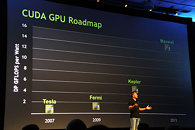- Joined
- Oct 9, 2007
- Messages
- 47,677 (7.43/day)
- Location
- Dublin, Ireland
| System Name | RBMK-1000 |
|---|---|
| Processor | AMD Ryzen 7 5700G |
| Motherboard | Gigabyte B550 AORUS Elite V2 |
| Cooling | DeepCool Gammax L240 V2 |
| Memory | 2x 16GB DDR4-3200 |
| Video Card(s) | Galax RTX 4070 Ti EX |
| Storage | Samsung 990 1TB |
| Display(s) | BenQ 1440p 60 Hz 27-inch |
| Case | Corsair Carbide 100R |
| Audio Device(s) | ASUS SupremeFX S1220A |
| Power Supply | Cooler Master MWE Gold 650W |
| Mouse | ASUS ROG Strix Impact |
| Keyboard | Gamdias Hermes E2 |
| Software | Windows 11 Pro |
At the GPU Technology Conference (GTC), an annual event hosted by NVIDIA, the company named the next two succeeding GPU architectures to Fermi (the current generation architecture on which are based GeForce 400 series GPUs). NVIDIA's next major GPU design change will come in the form of "Kepler", probably named after the German mathematician Johannes Kepler. The only concrete details about this architecture is that chips will be built on the 28 nanometer silicon fabrication process, and that going by the architecture's double-precision GPU compute performance per Watt represented on a graph, NVIDIA expects Kepler to be 4~5 times faster than Tesla, and over twice as fast as Fermi, again, at double-precision GPU compute performance per Watt.
Kepler is slated for 2011, though which part of the year will it be out (since AMD's answer to Fermi isn't far away), wasn't revealed. Looking much further away into the future, much like Intel mentioned Sandy Bridge's successor (Gesher) way back when unveiling Nehalem, NVIDIA talked about Kepler's successor slated for 2013. This one is called Maxwell, probably in honour of Scottish mathematician James Maxwell, with expectations of no less than three times the double-precision computation power per Watt of Kepler. These chips will be built on the 22 nanometer process.

View at TechPowerUp Main Site
Kepler is slated for 2011, though which part of the year will it be out (since AMD's answer to Fermi isn't far away), wasn't revealed. Looking much further away into the future, much like Intel mentioned Sandy Bridge's successor (Gesher) way back when unveiling Nehalem, NVIDIA talked about Kepler's successor slated for 2013. This one is called Maxwell, probably in honour of Scottish mathematician James Maxwell, with expectations of no less than three times the double-precision computation power per Watt of Kepler. These chips will be built on the 22 nanometer process.

View at TechPowerUp Main Site








